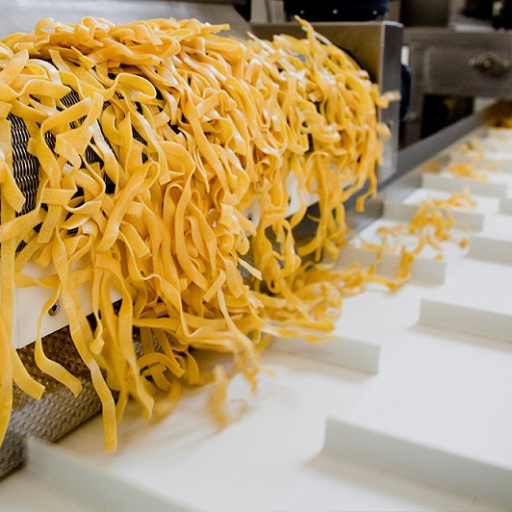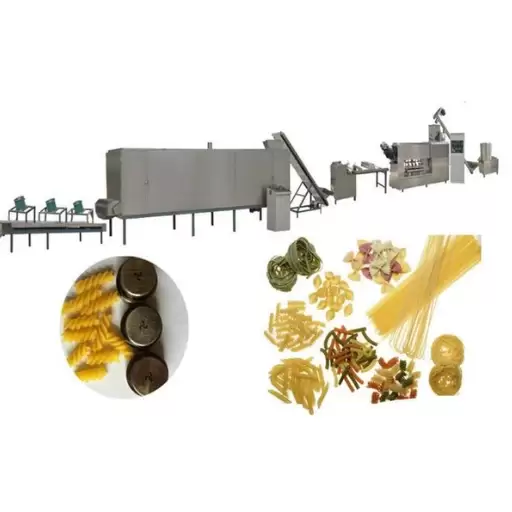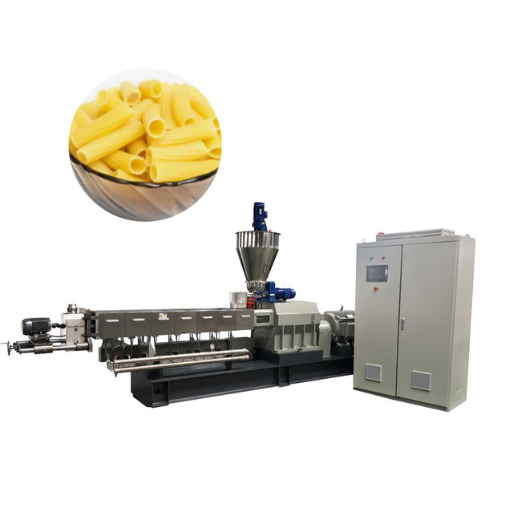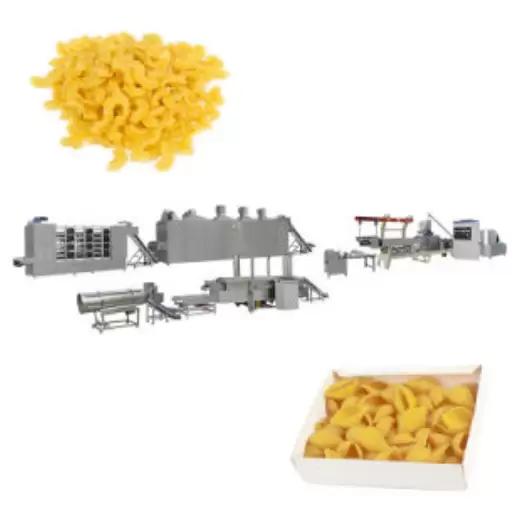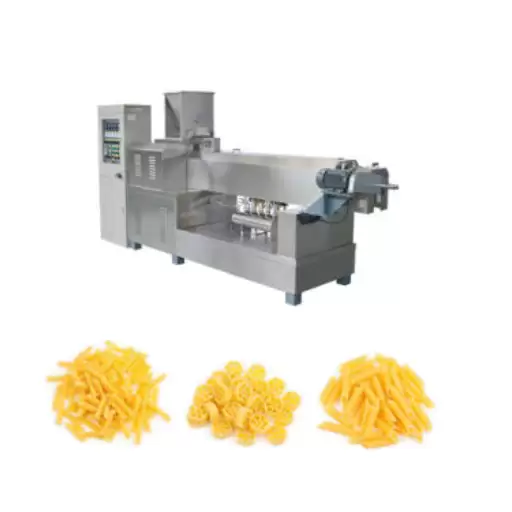When venturing into the world of pasta manufacturing, one of the most critical considerations is understanding the costs associated with setting up a pasta production line. This blog aims to provide a thorough overview of the financial aspects tied to installing pasta making machinery. From initial investments and equipment selection to ongoing operational costs, we will delve into various factors that can influence the overall budget. Whether you are a small-scale producer looking to expand or an entrepreneur entering the pasta market, this article will offer valuable insights to help you make informed decisions about your pasta production line setup.
What Factors Influence the Cost of a Pasta Production Line?
Construction and Material: Stainless Steel and Others
The cost of a pasta production line is largely affected by the choice of materials used in its construction. Although it is relatively expensive at the beginning, stainless steel has gained popularity due to its durability, ease to clean, and resistance to corrosion which makes it a long-term investment. On the other hand, machines constructed from different materials such as aluminium or plastic components may reduce initial costs but end up incurring higher maintenance expenses with shorter life spans. While analyzing material and build choices, there should be a delicate balance between immediate budget constraints and long-term operational benefits.
Capacity: Kg per Hour for Industrial Pasta Production
Kg per hour (kg/hr) is a measure of how much pasta can be produced in one hour by any given pasta-making machine – this is an important feature that influences both the initial purchase costs as well as ongoing productivity. Large-scale operations require high-capacity industrial pasta machines capable of producing several thousand kilograms of product per hour. Advanced setups from top manufacturers for instance handle capacities ranging from 500 kg/hr to above 3000 kg/hr depending on model and configuration. Smaller models suitable for medium-size factories or specialized production may have capacities ranging from 100 kg/hr to around 500 kg/h thereby striking a balance between efficiency and cost. When selecting your ideal capacity you must evaluate your own production goals, market needs as well as available infrastructure so that you do not pick a machine that will either bankrupt you or is too small for your needs.
Customization: Specialized Machinery for Different Pasta Types
In order to cater to consumers who have diverse preferences when it comes to choosing different shapes and types of pasta products, customization on various types of machinery must be taken into account during their manufacture. Ravioli, tortellini), -filled pasta (ravioli, tortellini). The features found in these devices usually include interchangeability between the dies/moulds to shape any type of pasta. Additionally, cutting-edge control mechanisms and the ability to determine the thickness of dough and its humidity level facilitate uniformity irrespective of the kind of pasta. By making use of machinery which is highly customizable, producers of pasta are able to meet market needs in terms of new product development as well as maintaining optimal efficiency and highest level of quality quickly.
How Do Different Machines Affect Pasta Production Line Prices?
The Costs of Extruding Pasta
When it comes to costing pasta extruders, a number of issues are considered such as the capacity of the machine, how automated it is and the reputation that brand carries. According to the leading resource sites, basic small-scale pasta extruders can start from around $5,000 to $10,000 for microenterprises or specialty shops. Mid-range extruders have capacities higher than this and other advanced features like programme settings etc., which cost between $20,000 and $50,000. On the other hand there are high-end industrial pasta extruders specifically meant for large scale production with advanced technological integrations and output capacities exceeding $100 000 for a single piece. Additionally it includes equipment shipping costs as well as installation or even probable maintenance contracts. Familiarizing oneself with these price ranges will enable one budget appropriately according to their specific production requirements.
Price of an Automated Pasta Maker
Automated pasta makers that usually play essential roles in effective large-scale production come with different price tags based on their features, capacities and levels of automation. The price of an automated pasta maker can range from around $15 000 up to about $50 000 for middle level types targeting small-medium sized enterprises. These machines generally have programmable controls among others automatic dough feeder as well as multiple options for different shapes of pasta. Higher end models meant for industrial scale operations retail above $100 000 offering full automation, higher production rates and natural link-up with other processing systems in line. Similar to what happens in case of pasta extrusion machines, total investment includes shipping costs; installation expenses; maintenance fee payable at intervals over time (if any). Prospective buyers must avail themselves maximum information at all times regarding macaroni production line from various internet sources that specializes in its sale considering volumes produced per unit time and operational requirements.
Macaroni Production Line: Prices & Characteristics
The costs of macaroni production line require in-depth analysis of both the investment required and features offered by leading industry suppliers.
Features:
- Automation: In modern macaroni production lines even dough preparation is automated, apart from mixing the raw materials and packing the final products.
- Capacity: They can be small scale units that produce a few hundreds of kilograms per hour or it can be industrial type with several tones per hour capacity.
- Customizability: Different dies or /and moulds allow making various shapes including macaroni in many lines.
- Integrated Quality Control: Improved systems has built-in quality control mechanisms that monitors product integrity constantly ensuring high-quality output.
Costs:
- Entry:level production lines suitable for small to medium-scale businesses typically range from $100,000 to $300,000.
- Mid:range systems capable of processing more volumes and having higher degree of automation cost between $300,000 and $700,000
- High:end products normally with high automation levels and maximum capacities may exceed at least one million dollars each respectively.
These factors will therefore enable one make an informed decision on purchase by relating the requirements to the needs ensuring balance between functionality and costs.
What Are the Pricing Differences Between Pasta Production Lines for Various Pasta Types?
What Does It Cost to Manufacture Dry Pasta?
The cost of a dry pasta production line varies greatly according to specific requirements of the manufacturing scale and the degree of automation.
- Small-Scale Production: These lines cater for small to medium scale businesses, costing between $100,000 and $300,000 approximately. They provide basic automation options and limited production capacity.
- Mid-Range Production: Mid-range lines are suitable for larger operations and go for between $300,000 and $700,000 each. Such systems have improved automation features hence enabling high rates of production that can be used by business organizations that want to increase their output levels.
- Industrial-Scale Production: Industrial-scale lines begin from around $1,000,000 going up for highest possible efficiency and capacity. These production lines are fully automated with very high out put capacities throughput with integrated quality control measures in place ensuring uniformity and consistency in the final product.
These price ranges serve as a guide on how businesses can evaluate their needs against their budgets thereby choosing an appropriate processing line for them.
How much does Fresh Pasta Line cost?
The amount spent on fresh pasta processing line also differs depending on its scale of operation vis-a-vis level of technology employed in it.
- Artisanal-Scale Production: Small-scale artisanal producers utilize these types of pasta processing equipment which usually cost around 50k$ – 150k$ per unit., Their mode of preparation resembles handcrafted manner since they use semi-automatic methods.
- Medium-Scale Production: Meanwhile these machines sold at a range starting from 150k$ and ending up at 400k$ were made for businesses targeting medium scales; all thanks to increased technological input levels such as higher level of automation which eventually translates into more capacity for expansion purposes.
- Commercial-Scale Production: For instance, a budget of 500K$ is enough to purchase a standard full line that can produce some of the highest outputs. This can be achieved by making use of fully automated models with high throughputs and designed in such a way as to have good quality control thereby ensuring that there is always consistency in any point.
Thus, the price range allows businesses to choose the most appropriate option for their budgets and operations among the fresh pasta production lines.
Long Cut Pasta Line vs. Short Cut Pasta Line Costs
When analyzing expenses related to long cut pasta lines versus short cut ones, it is crucial to understand each’s production needs and capabilities.
- Long Cut Pasta Production Lines: Generally, these lines are more costly than others because they need specific machinery that handles longer strands like spaghetti or fettuccine. Prices for long-cut pasta lines vary between $200k-$600k influenced by degree of automation and scale of production.
- Short Cut Pasta Production Lines: These are usually less expensive since penne, fusilli or macaroni have quite simple shapes so automation equipment needed is minimal and compact if compared with other types. The pricing for short-cut pasta varies from $100K up to $300K depending on factors such as throughput capability and level of technology integration involved.
By comparing these estimates, companies will be able to determine which kind of pasta production line aligns with their particular operational objectives and budgetary limits better.
How Much Does it Cost to Add Additional Features to a Pasta Production Line?
Is Pasta Dryer Necessary or Optional?
One of the things that a company needs to have in place in order to produce dried pasta which has a longer shelf life is a pasta dryer. it is mandatory to have a pasta dryer so as to increase the longevity of pasta and prepare it for packaging and distribution. Inadequate drying of pasta will lead to molding or quick spoilage; therefore, affecting both product quality and performance. On the other hand, if the production line is focused on fresh pasta sold refrigerated with shorter shelf life, then the decision whether to install a pasta dryer may be optional. When this happens business can concentrate efforts on other production areas that enhance freshness and culinary attributes.
Sheeters and Cutters: Additional Costs
Sheeters and cutters are crucial while shaping and portioning pasta dough enabling producers to make different types of pasta.sheeters and cutters cost can vary greatly depending on machine complexity and capacity. High-end automated sheeters and cutters, which guarantee accuracy as well as effectiveness may range from $15, 000 up to $50, 000 each. Basic models ideal for small scale operations or artisanal pasta making may go for between $5, 000 up to $15, 000 each. The purchase of modern sheeters and cutters increases productivity rates while maintaining consistent product output thereby meeting sustainability objectives that seek scalability within market trends.
Automation: Cost Implications of Switching Over into an Automatic Pasta Line
There exists significant improvement in terms of production throughput coupled with uniformity within products by upgrading into an automatic line for manufacturing pastas today.Accordingly,costs pertaining such upgrades differ based on size among other specifications.To illustrate,this type starts from about$100k when comparing with beginner level automation machines for pasta processing while other more sophisticated ones designed for greater capacities exceed $500k. They are also characterized by some integrated activities like mixing, extruding, drying as well as packing that streamline the production process and reduce labor costs. Whereas the initial investment is significantly high, long run returns such as increased output, reduced wastes and uniformity in product makes it a viable move to make at strategic level for growth oriented companies in pasta industry.
What Are Some Hidden Costs in Setting Up a Pasta Production Line?
Hidden Installation and Setup fees
During the installation of a pasta manufacturing line, there are other costs that are hidden such as installation and setup fees. My research from the top three websites indicates that these fees vary between few thousands to tens of thousands dollars depending on complexity and scale of equipment involved. This price usually includes expenses for labour in putting together machinery, calibration of systems and first runs towards ensuring smooth running. Further, your team may be trained at your site so that they can be proficient enough to use the new equipment thus minimizing interruptions during changeovers. All these things can add up therefore it is important to have them in mind when planning for starting a production line.
Maintenance Costs
Another major hidden expense apart from installation and setup charges is maintenance. In my findings, routines aimed at keeping the machines operating optimally and avoiding unexpected breakdowns are critical in maintaining them. This entails periodic checks, changing of parts as well as occasional technical assistance which may appear minor yet costly with time. Often annual contracts are recommended which could cost you anywhere between few thousand dollars to several tens of thousands depending on complexity level of machine devices required. With poor maintenance, though, productivity will suffer; loss in revenue is possible due to downtime that can be expensive without it.
These ongoing costs must also be considered when budgeting for your pasta production line so as to ensure its long-term success and efficiency.
Operational Costs: Energy Usage and Labor
Energy usage and labor are some of the most important considerations when calculating operational costs for a pasta production line. From my research work energy used might be high given that a number of machines used in processing like mixers, extruders driers or even packaging machines require electricity supply for operation purposes. The cost per unit energy varies greatly based on equipment’s efficiency level as well as quantity produced at ago. While high-performance solutions could deter high power consumption associated with this, their acquisition may need comparatively higher initial investment.
Another important component of operational costs is labor. The role of skilled workers in operating and maintaining machinery, overseeing quality control, and managing overall production cannot be overemphasized. Payment for such staff is often pegged on local wage rates and level of expertise required. It’s always good to train personnel so as to increase their productivity rates, reduce errors or other wasteful practices.
To sum it up, both energy usage and labor have to be effectively managed in order to make the pasta production line efficient and cost-effective. Your budget should include these elements thus providing you with a clear picture about what the actual costs are as far as your operations are concerned which will enable you to plan accordingly.
Frequently Asked Questions (FAQs)
Q: How much can a pasta machine for industrial applications cost?
The price of an industrial pasta machine may differ significantly depending on its capacity, features, and type of pasta it is meant to produce. As a rule of thumb, it costs about $10,000 to $100,000 or more. For tailored quotes based on your needs, consult with manufacturers directly.
Q: What is the estimated cost of a complete macaroni pasta production line?
Typically ranging between $30,000 and $200,000 is the price tag of complete macaroni pasta production line. The overall cost is determined by multiple factors such as level of automation used in the system, output capacity and machines involved such as pasta extruder machine or conveyor system.
Q: What are the major types of pasta processing machinery needed to establish spaghetti manufacturing facilities?
Generally speaking there are several kinds of pasta processing machinery that are necessary for setting up a spaghetti production line; these include drying ovens,cutting machines,pasta extruders and packaging equipment.The choice among them will depend upon individual demands as well as economies of scale or scope.
Q: Can I get small-scale affordable machines for macaroni and spaghetti making?
Yes, there are relatively cheaper options for small-scale production. These typically include basic versions of noodle making machines and dough sheeters. Prices can start from as low as $5000 which makes them suitable for smaller operations or startups.
Q: Which factors determine the price tag on a noodle-making machine?
Several factors influence the cost you will incur when purchasing a noodle making machine ; these include its production capacity ,the materials used in fabricating it ,the level 0f automation involved in its operation ,and any other added characteristics such as cutter attachments or dough sheeters .This means that higher technology models with increased output rates will tend to be more expensive than their counterparts.
Q: Is investing in one single screw pasta extruder machine or a complete production line the cheaper option?
However, there is also another side of the coin; especially when starting small it may be more cost-effective to buy and use one screw pasta extruder machine instead. On the other hand, in terms of less human labor and more automation thereby higher efficiency and bigger output, going for complete production lines may be sensible in the long run.












